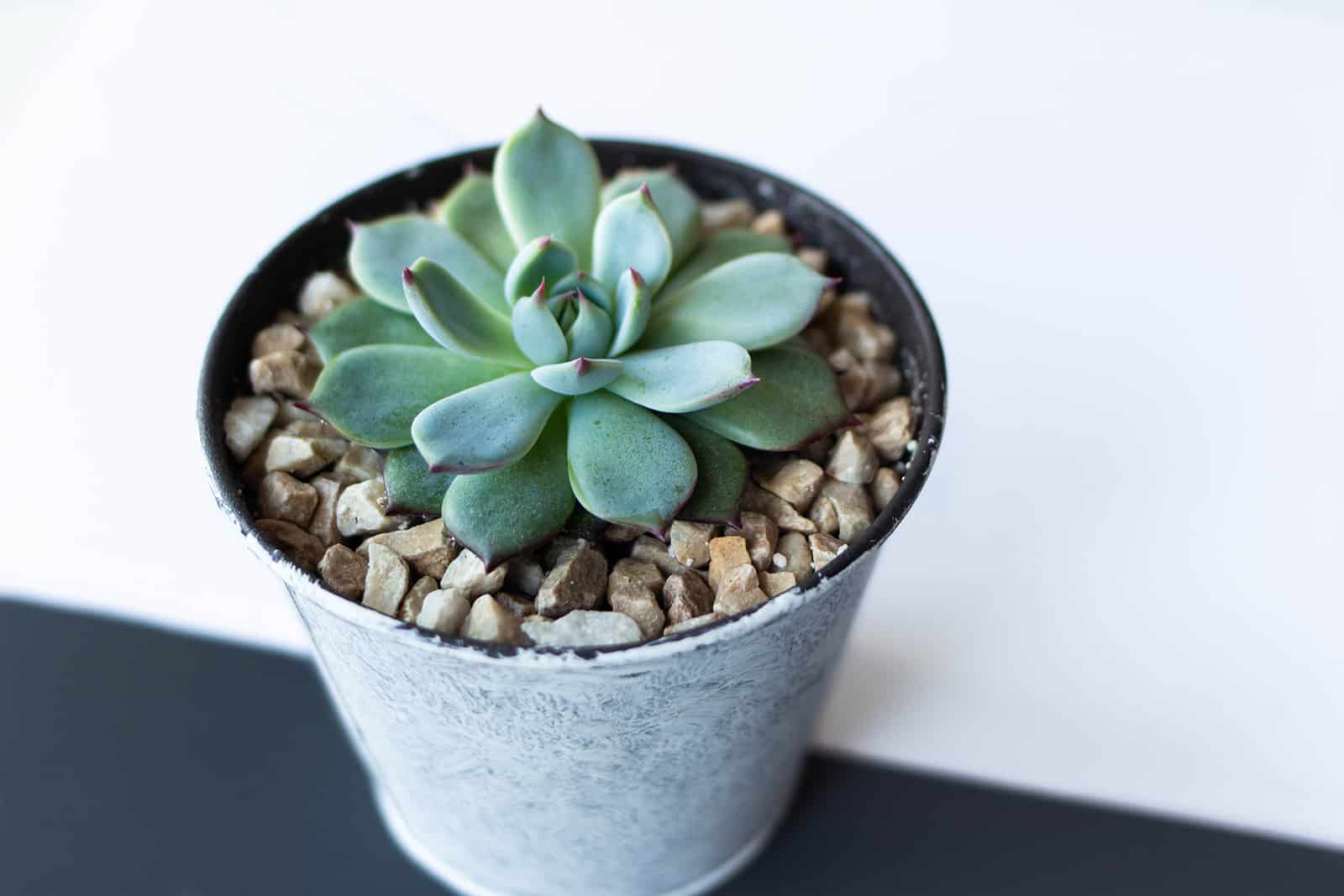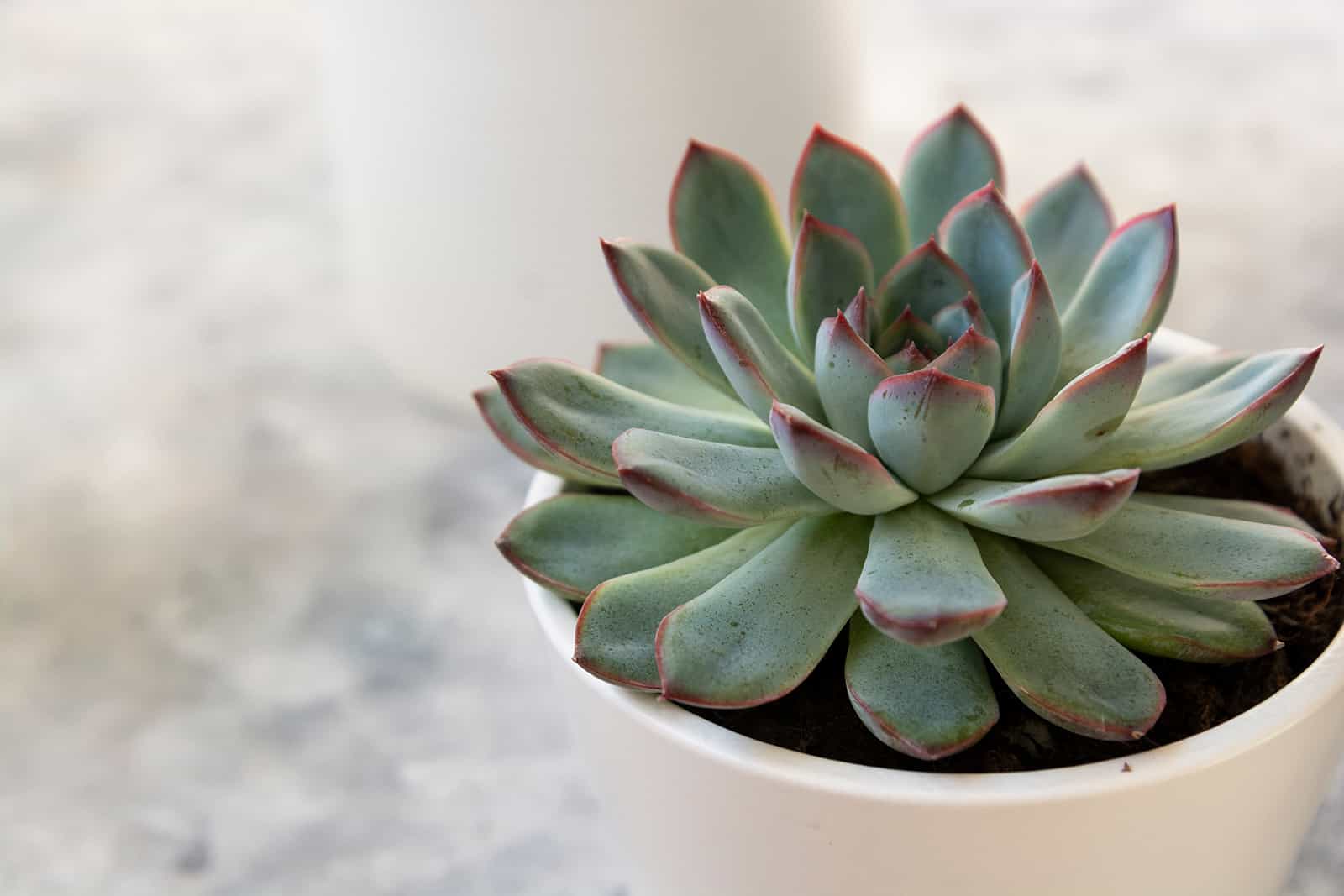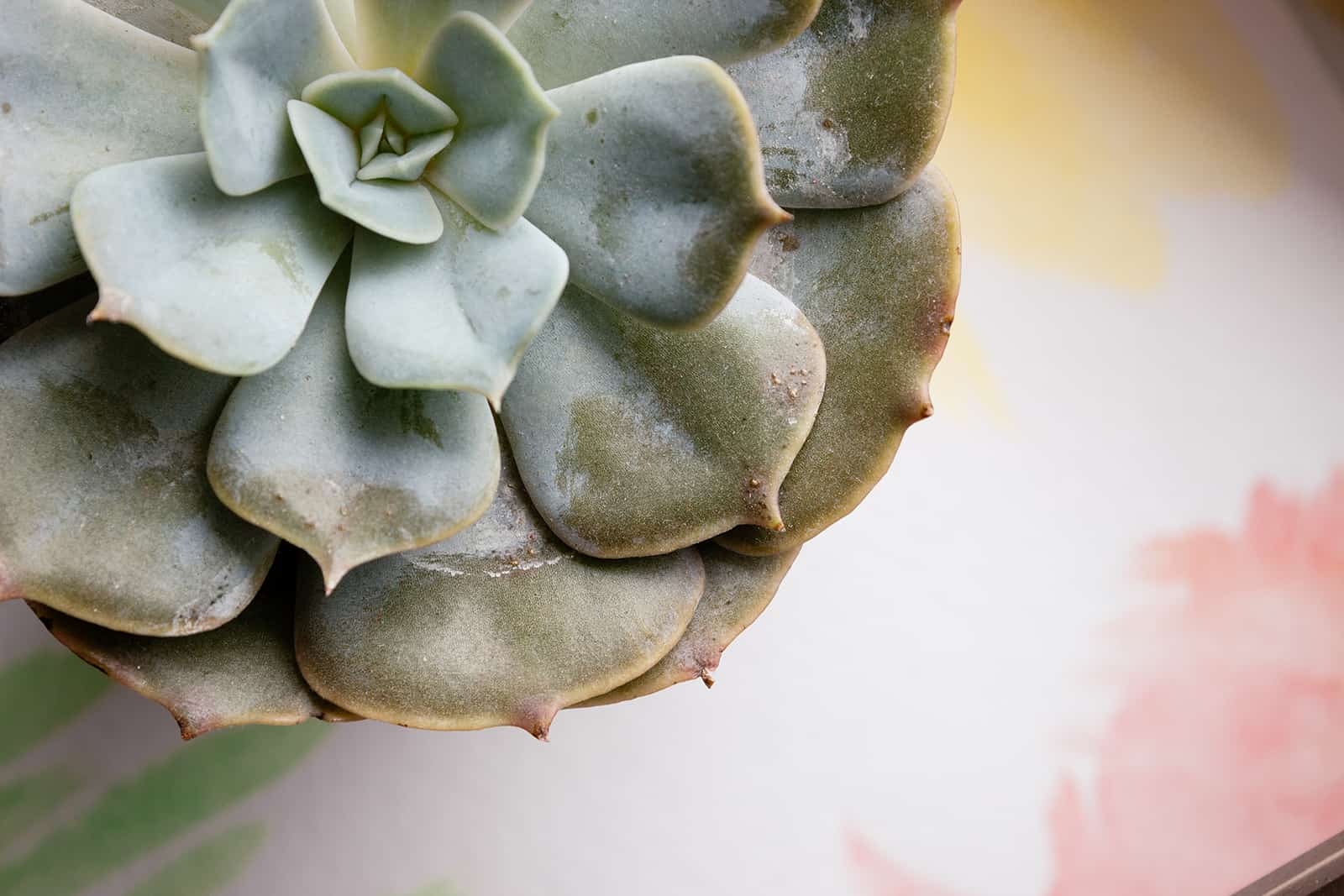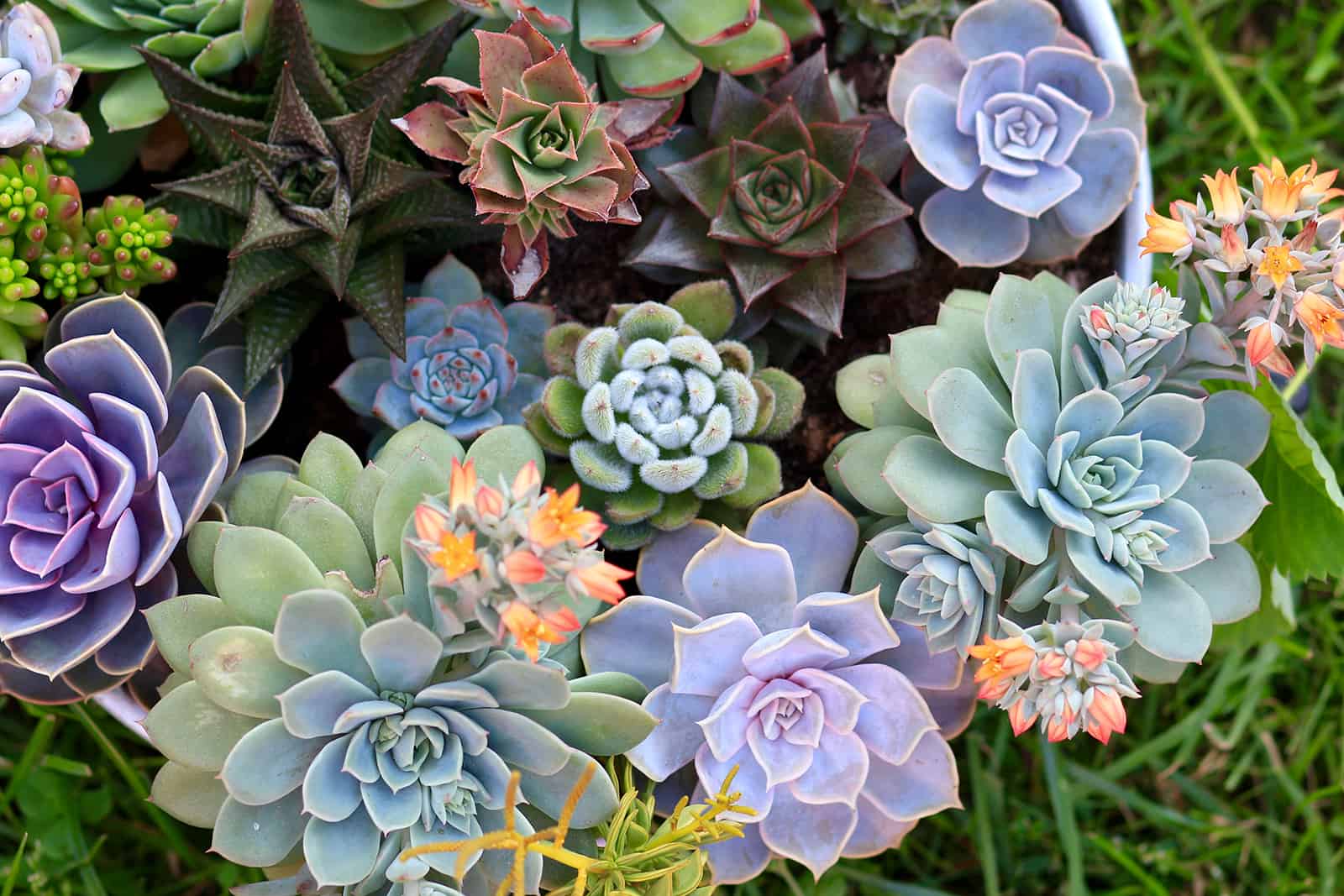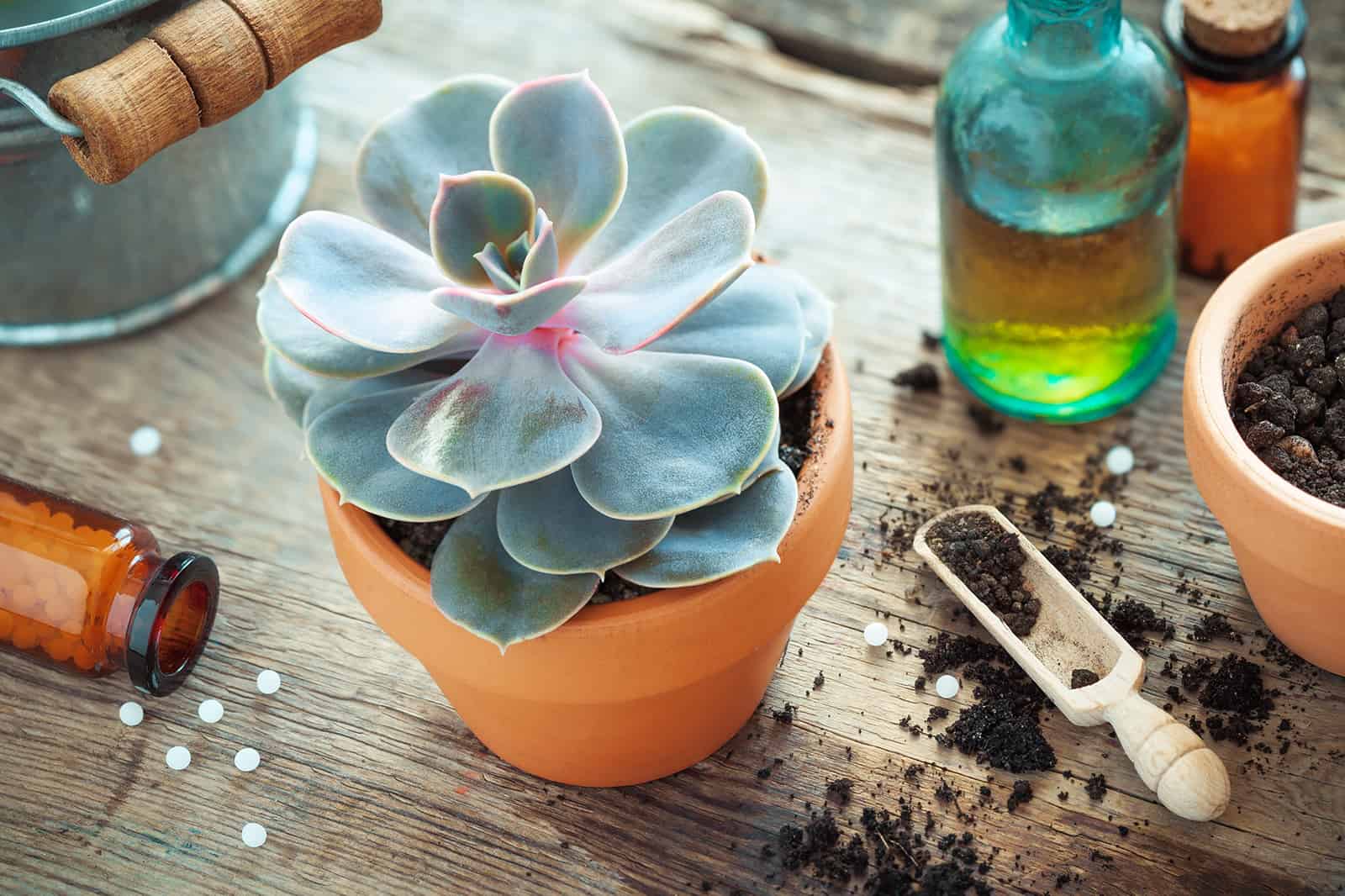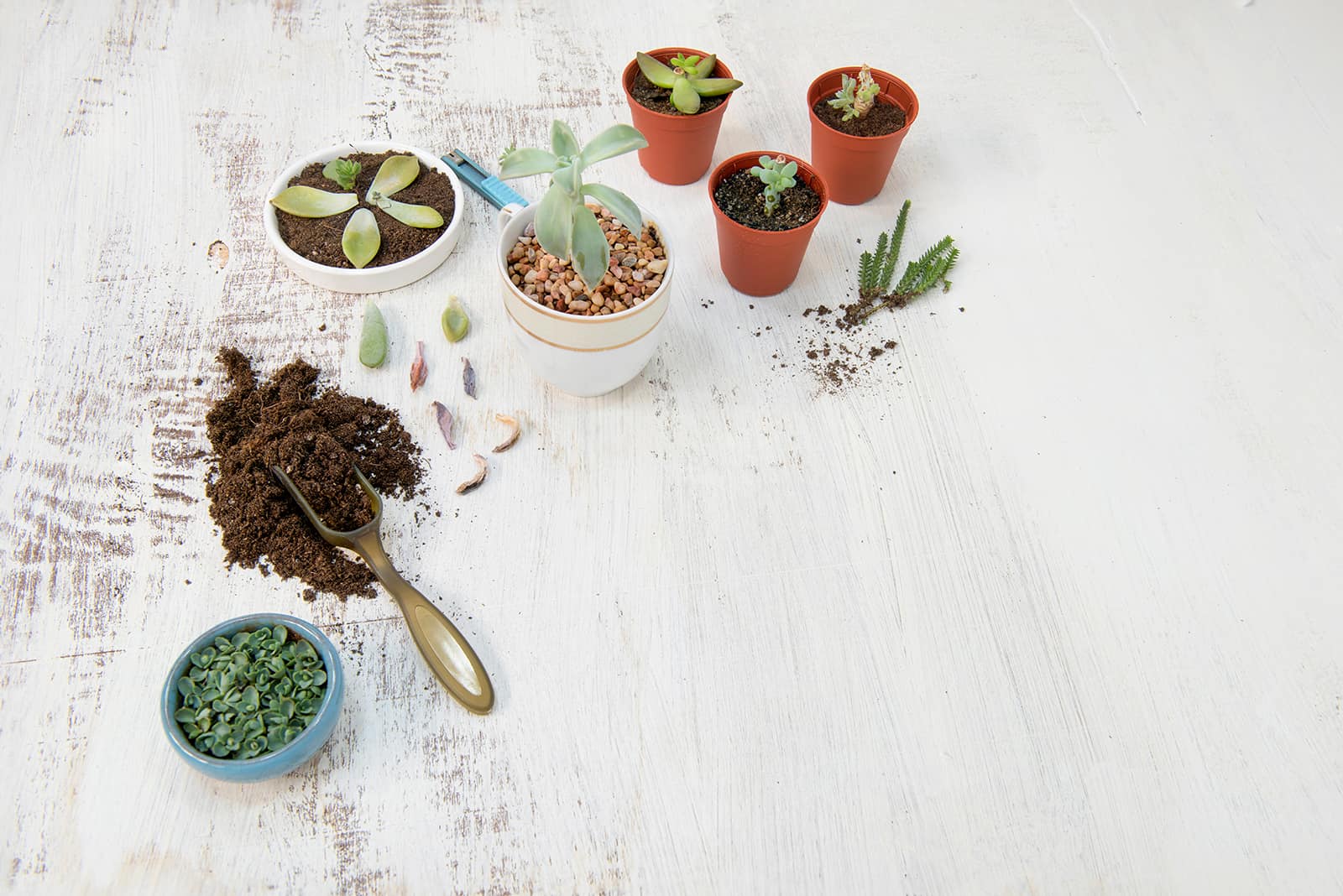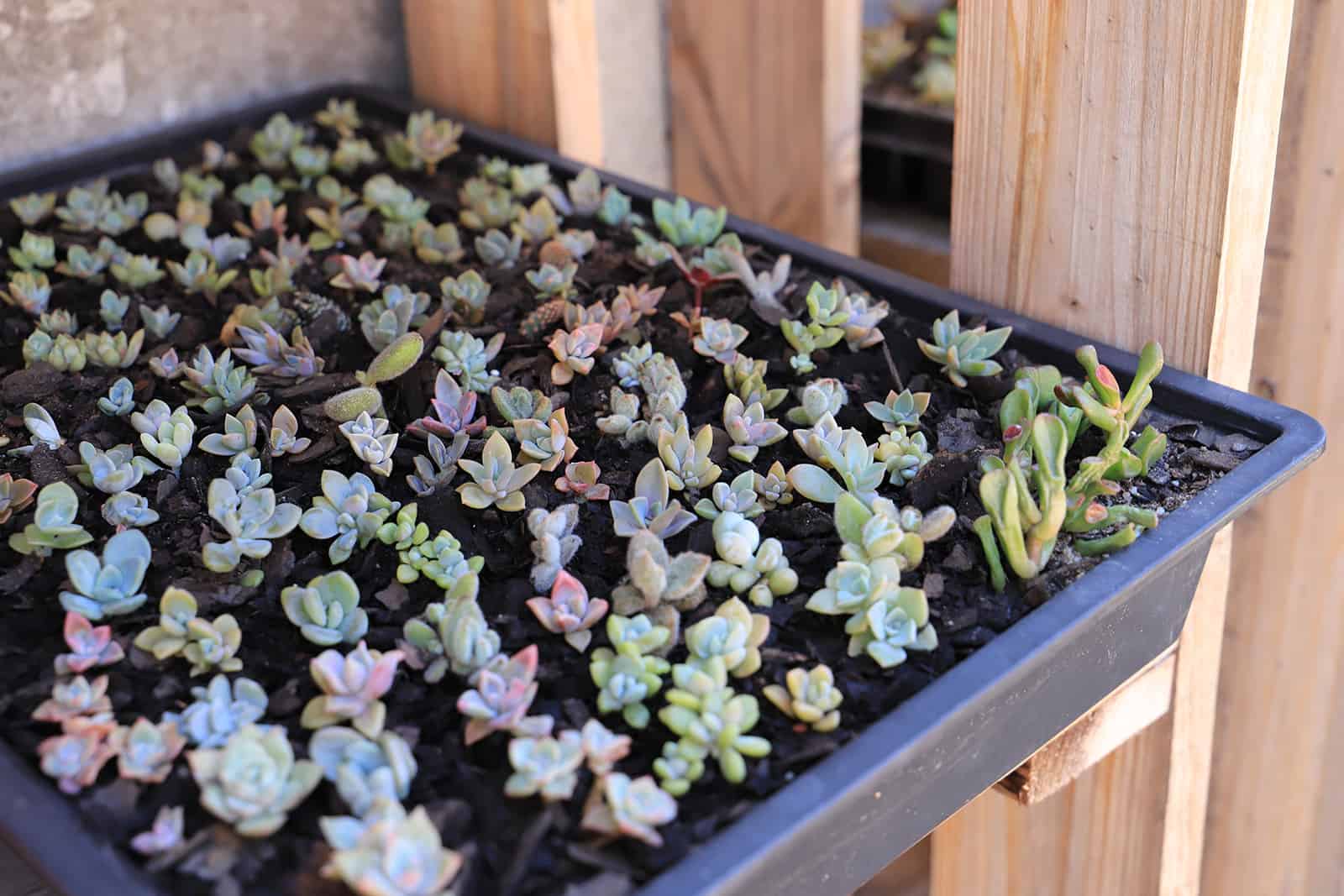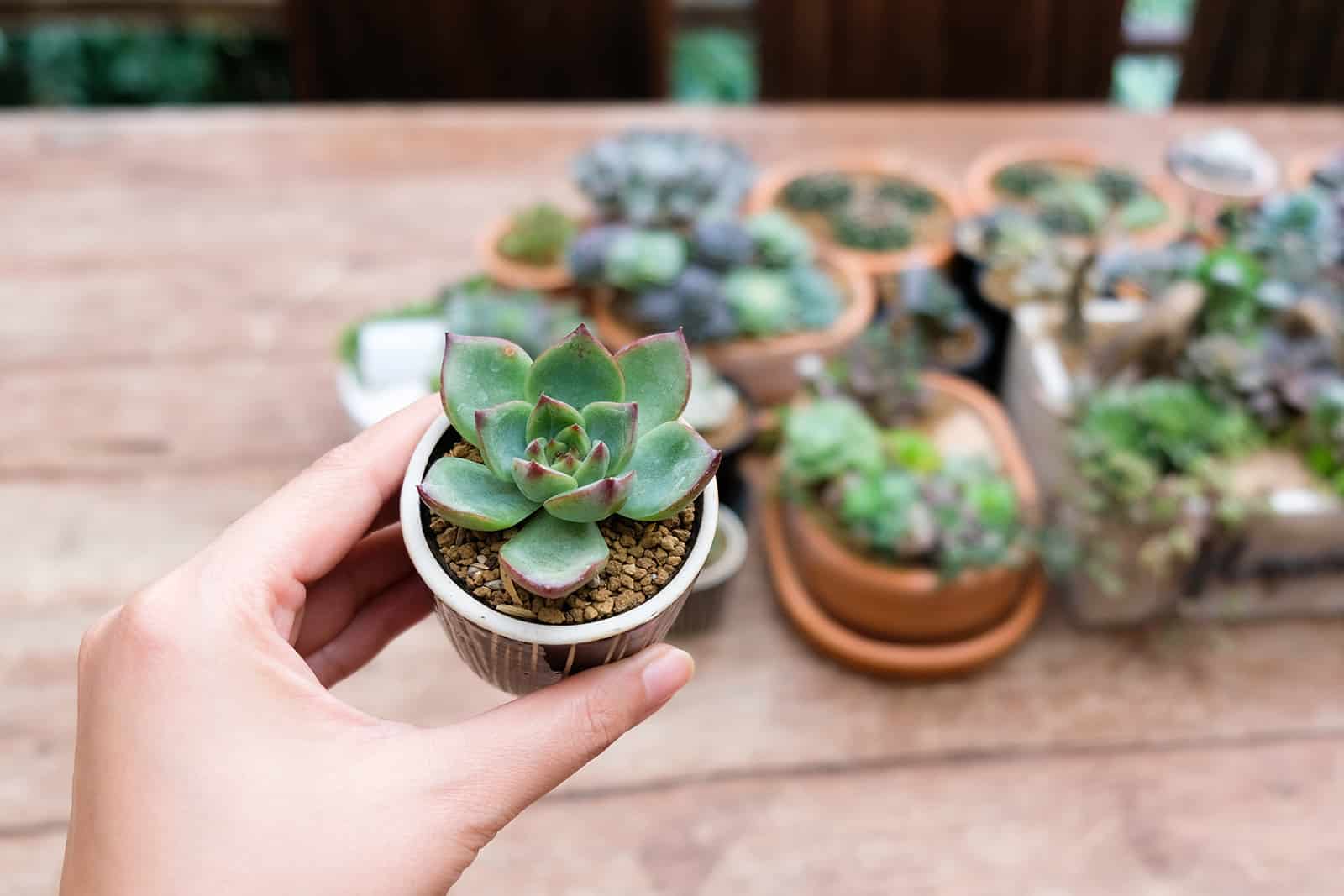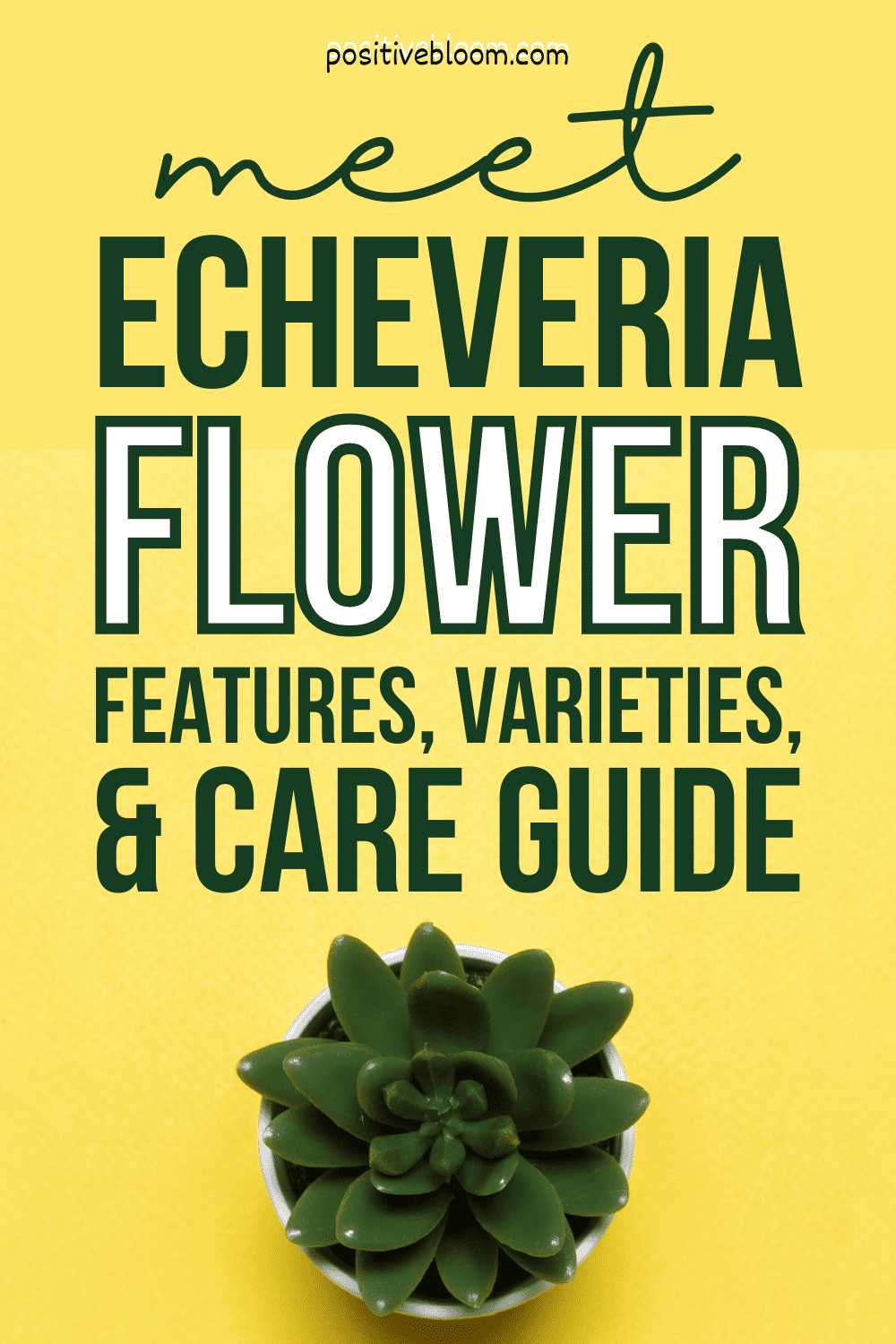The Echeveria flower is our favorite succulent. It is a large genus with many different flowers, but we love them all.
In this article, you can read all you need to know about the flowers of these succulents and their care guide. You can also find out about the different types of echeverias and choose the best one for your home.
All the varieties are low-maintenance succulent plants, so you’ll only have to choose which one you prefer, orange or white.
Before we get into any detail, here is the basic information about the Echeveria genus:
[table id=74 /]
Now that you know some general specifics about echeveria plants, it’s time to examine the actual flowers more carefully, and then we’ll move on to the different species and the care guide.
Let’s begin!
Features Of Echeveria Flower
Echeverias are members of the Crassulaceae family and sisters of sedums and kalanchoes. Species of echeveria differ not only by the color of their flowers but also by their foliage and stems.
In the following section, you can read about the Echeveria genus and learn the differences between the species.
Echeveria Flower Stalk
Echeveria flowers produce one of the most beautiful flower stalks you will ever see. They are usually the same color as the foliage, pastel blue or green. However, some stalks turn pink, which adds some sparkle to the already breathtaking plant.
Each stalk produces dozens of vibrantly-colored flowers, but unfortunately, they don’t last forever. However, when the time has come to cut off the flower stem, you can still save it for later.
Put it in a bag where it can dry out, and then you can collect the seeds afterwards. Use the seeds for propagation and you can cheer up a friend with a new plant.
However, flowers need to be pollinated to produce seeds. Therefore, if there aren’t many bees or other insects around your plant, you will need to get your paintbrush out and start pollinating.
Appearance And Blooming Time
When I first started collecting echeveria flowers, I couldn’t decide which one to buy. But now, I know that you can buy any variety and won’t be disappointed.
The color of echeveria blooms is primarily pink, orange, or peach, but you can also find them in red, yellow, and white.
Most varieties bloom in late spring to early summer, but some species can put a smile on your face in fall as well. The flowers usually last for about two weeks, but don’t let this discourage you.
It takes many weeks for them to finish the growing cycle, and the stalks themselves are quite a sight!
Echeveria Flower Death Bloom
You don’t have to worry about death bloom if you have echeveria flowers. They are polycarpic plants that usually bloom once a year, and they repeatedly bloom until they experience death bloom.
And now you may wonder, what is death bloom?
It is just a poetic expression that symbolizes a plant’s final bloom; plants bloom, produce tiny seeds and then die.
But, it is not brutal as it might seem; you still have the seeds of your plant, which you can use to plant a new one and enjoy its flowers and stems.
Common Issues Of Echeveria Succulents
All indoor plants experience issues, and the echeveria plants are no different. However, there are remedies for some problems, but the best cure is prevention.
In this section, you can read about the most common issues that echeverias encounter and how to either prevent them or deal with them.
Let’s take a look!
Pests
The three most common pest varieties are mealy bugs, spider mites, and fungus gnats. You can prevent the appearance of pests by keeping your plants healthy and tending to their needs.
However, if one of your echeveria plants is suffering from a pest infestation, here is what you can do:
Isolate the plant. Separate the infested plant from the rest so that the pests don’t spread onto your other plants.
Act immediately. Don’t wait until the infestation becomes unbearable and you can’t even see the plant through all the pests. As soon as you notice these nuisances lurking around, try to get rid of them.
Try less toxic methods first. You can try and pick the bugs off one by one if the infestation is small. If however, they appear in bigger groups, you can use a strong water spray to wash them off.
You can also use rubbing alcohol and a Q-tip to remove the bugs one at a time, but you will have to be extra careful not to touch the plant, as the alcohol can cause damage to the foliage and the stems.
Use insecticides. If nothing seems to be working, use neem oil or insecticidal soaps to put an end to the pest infestation.
Diseases
You should dread the fungal diseases of echeveria, as they are rarely curable. Root rot, leaf spot, and powdery mildew are just some of the infections that your plants can catch.
These are caused mainly by excess water and humidity, therefore, you shouldn’t overwater these flowers if you want to prevent these diseases. You can do some things to help your diseased plants, but there’s no guarantee of curing them.
Isolate the plants. Again, the first step is to isolate your plants. Some fungal infections can spread from plant to plant, and you don’t want to have a whole garden of plants infected with leaf spot.
Act immediately. If you deal with the issue quickly, there may still be time to save your plant. As soon as you notice any discoloration of the leaves or any stunted or leggy growth, check both the roots and the foliage of your plant.
Treat the plant. If your plant is suffering from root rot or soft rot, you need to remove the infected roots, repot the plant, and stop watering it so much. If you do notice leaf spot, the first step is to prune the infected leaves.
Later on, reduce the humidity, and put some charcoal powder on any of the foliage that cannot be cut off.
If you’re dealing with powdery mildew, you can try to treat the diseased foliage with a baking soda solution, but you should cut them off if that doesn’t help.
Most importantly, reduce the humidity and watering, and this should help to ensure that none of these diseases afflict your echeverias!
Varieties Of Echeveria Flowers
Now we get to the most exciting section, where you get to see for yourself how beautiful echeveria flowers actually are.
Below, we bring you our favorite varieties of echeveria, to help you decide which one to buy first.
But you should also know that none of the following varieties require much maintenance, so you can buy them all without causing yourself too much trouble.
Echeveria Agavoides
The Lipstick echeveria, or Echeveria agavoides, is an amazing star-shaped succulent. Vibrant pastel green foliage is framed with vivid red edges. The leaves form tight rosettes that are great additions to rock and succulent gardens.
In spring, they produce red flowers that introduce a specific sparkle to your home that leaves no one indifferent.
Echeveria Elegans
The common name of Echeveria elegans is hen and chicks, and it truly is an elegant plant. It is also commonly known as a Mexican gem, white Mexican rose, or Mexican snowball.
The small rosettes of pastel blue or green open and let through a unique pink-red stalk that bears pink flowers with yellow tips.
They typically appear in late winter or early spring and last for about two weeks.
Echeveria Minima
Echeveria minima or Miniature echeveria is a gorgeous little cluster of leaves. Blue-green foliage is edged with pink and forms the cutest rosettes.
The stalk shoots from the middle and produces tiny pink and yellow bells in late spring.
Echeveria Peacockii
The common name of this colorful plant is the Mexican peacock Echeveria. Its correct scientific name is Echeveria desmetiana, but it is widely known as Echeveria Peacockii.
Pastel blue foliage forms flower-like rosettes that can move even the hardest of hearts. Pink-orange blooms appear in the spring or early summer and usually last for about two to three weeks.
Echeveria Purpusorum
The Rose of Urbinia looks a bit different from the abovementioned succulents. Its gray-green foliage with bright red edges, forms spiky rosettes that sometimes look like arrow or sword tips.
They cannot hurt you, but they mesmerizingly attract your gaze, making you unable to look away.
They produce flaming red flowers with yellow tips in late spring or summer, bringing color and warmth to modern home decor.
Echeveria Flower Care Guide
Hopefully, you have decided which echeveria species you want to buy. This following section can’t make your choice easier, but you will learn everything you need to know about caring for your echeveria flowers.
They need plenty of sunlight and just a little water to grow big and strong.
Remember, the right conditions are key to growing echeverias!
Light Requirements
The main thing to know about echeverias is that they need full sun for healthy growth and bright colors. However, they cannot withstand direct sunlight, especially in the summertime.
It is best to keep your echeveria in the safety of your home where it can avoid the midday sun and any drastic changes. You can’t just move it into the shade at noon and make everything right; trust me, I know!
You can keep your plant in a sunny window, where they will get enough light to prevent any stretching and legginess.
Water
The best care tip for succulent houseplants is to stop watering them frequently. Echeveria genus is drought-tolerant and super easy to care for, until you water them one too many times.
You can water them once a week, or even less if the weather is more humid than usual. The basic rule is to check the soil first, and if the first few inches of the topsoil are dry, then you can water the plant.
However, winter watering differs from watering in the summer. Echeveria succulents store water in their foliage, and once they enter dormancy, they don’t need so much water to survive.
Finally, always water the plants at the soil level because water on the leaves doesn’t only make them unattractive but can also lead to fungal infections.
Climate And Temperature
Echeverias are used to arid, warm climates, and they will do best in places that mimic these conditions.
The first thing you need to be careful of is the humidity. High humidity levels can lead to leaf spot and powdery mildew, so you shouldn’t keep your hen and chicks in bathrooms or other humid rooms.
This feature makes them perfect houseplants, as the average room humidity is ideal for them. You don’t have to spend time misting them, assembling pebble trays, and purchasing humidifiers.
Finally, if you live in a region where humidity is over the charts, you don’t have to say goodbye to succulents; you can simply invest in a dehumidifier and your echeveria will thrive.
Soil And Fertilizer
The ideal substrate for growing echeverias is succulent soil with a mildly acidic pH level (around 6.0).
They need well-draining and aerated soils to survive. If you have forgotten to buy a succulent mix, you can always create your own.
Add plenty of perlite or sand to your favorite potting mix, and that’s it. Fertile soil is not a requirement because it often retains more moisture, and moist soil is a big no-no.
For that reason, you don’t have to fertilize the echeveria flower frequently, but if you want, here’s what you should look out for.
Fertilizer
Firstly, be very careful when fertilizing this succulent as they are used to infertile soils and don’t require much fertilizer. It is best not to fertilize them because fertilizing can often lead to fertilizer burn.
However, if you feel that your plant does need extra food, you can use cactus fertilizer during its growing season. My favorite method is to feed my hen and chicks with manure tea after it wakes up from dormancy.
I find that fertilizing it once a year works best, and I still haven’t had to deal with fertilizer burn.
You can also use liquid fertilizers, diluted to quarter-strength, but we prefer all things organic.
And lastly, never fertilize this plant during fall and winter when it enters dormancy. It cannot use the nutrients you feed it with, and it will only lead to over-fertilization.
Repotting
Echeverias don’t usually grow too tall, so frequent repotting is not needed. However, they like fresh soil and nutrients, so you should repot these plants once every two years.
The best time to repot is spring, when this plant is actively growing. Once you repot it, it will have plenty of time to adjust to the new pot and soil before dormancy.
Once you have chosen a new pot, fill it with the fresh, well-draining substrate, and plant your succulent in it. However, make sure to remove the old soil from the roots first and cut off any dead or dying roots.
Finally, don’t water your newly repotted plant; this will only lead to soft roots and root rot. Give your plant some time to adjust to the new soil, and then water it slightly.
Here’s a short video that will help you repot echeveria for the first time.
Remember, less is more with succulents!
4 Propagation Methods
There are four propagation methods for expanding your echeveria garden, and you’ll only need to figure out one which works for you.
We love propagating echeveria flowers by seeds, as this way you can witness the whole process. However, we’ll bring you four different methods so that you can try them all and not waste any part of your plant.
Leaf Cuttings
Propagation by leaf cuttings is probably the easiest method and is safest for beginner gardeners.
Remove the healthy, fleshy leaf from the plant and leave it in a warm and bright place for a few days to heal. Put the leaf on the moist soil you have prepared for this occasion, after you notice that the wound is closed.
After the soil has dried out, mist the leaf and keep it in a place where it can get plenty of bright, indirect sunlight. The leaves need to be kept warm and moist if you want this process to succeed.
You will notice new growth within a few weeks, but don’t pot the plant just yet! It might take many months before the plant is ready to be placed in a pot, and you will know it’s ready when the old leaf falls off.
Flower Stems
When propagating with flower stalks, make sure you plant the stems in late winter or early summer, when the plant enters the growing season.
Choose a stalk that is healthy and actively growing (they are shorter than old stems), and cut it off with a sterilized knife. Make an incision as close to the base as possible.
Again, leave the plant to heal, and once the wound has closed, plant it in a pot and keep it in a spot that gets plenty of bright, indirect sunlight. You can give it a drop or two of water, but no more, as too much can destroy the process.
After a month, the new plant should have a developed root system.
Seeds
Propagation with seeds takes a lot of time, but you can monitor each growth stage of your plant. Fill a container with succulent potting mix and soak it with water. After the excess water has drained through the potholes, it is time to prepare the seeds.
Keep them in lukewarm water for about half an hour to loosen up, and then put them on the soil. Make sure you leave some distance between the seeds, so they have space to grow.
After that, cover the seeds, put a thin layer of soil on top of the seeds, and lightly spray it with water once a day or when it feels dry to the touch.
You should keep the seeds in a warm place and cover them with a plastic sheet to maintain the temperature and moisture of the soil.
After a few weeks, seeds will germinate, and in a month and a half, you can start watering the new plant every two days.
Offsets
Offsets are the little plants that grow around the base of the mother plant. If you want to propagate the plant using offsets, you need to be extra careful.
First, take the plant out of its container, clear away the dirt from the roots, and divide them carefully. Younger offsets won’t have their own root systems and will be attached to the parent plant, so you’ll have to use a sterilized knife to divide them.
On the other hand, older offsets do have developed roots, so you can just untangle their roots from the mother plant.
Let the roots dry for a few days before planting the offsets. Keeping them in a warm place where they get plenty of indirect light is vital, as this method prevents root rot and other fungal diseases that may afflict the plant after repotting.
After the roots have dried, plant the succulent in a container filled with a well-draining medium, water the soil, and plant the offset.
Q & A Corner
You now know the most important things regarding the echeveria flower features and its care guide, but that’s not all you need to know.
There are many things about echeveria flowers that we did not cover in this article, and in this section, you can read the answers to the most frequently asked questions about this stunning plant.
How do I care for my echeveria after it has flowered?
Flowering echeverias require more fertilization and watering if you want to make their blooms last longer.
You should fertilize your flowering plant once a month instead of once a year, using a phosphorus fertilizer diluted to half-strength. After the flowers start to fade, you can stop with this fertilization schedule.
Also, water your flowering succulent more when it blossoms.
Whenever you feel that the top two inches (5 cm) of the soil are dry, irrigate the plant thoroughly, let the excess water drain through the draining holes, and then wait until the topsoil is dry again.
What is the lifespan of echeveria?
Echeverias are perennial plants that can live for a few decades.
Some varieties, however, only reach three or four years before their death bloom, but there are varieties that can live more than ten years. It is up to you to decide which variety you prefer.
What are the benefits of echeveria flowers?
Echeveria flowers purify the air, produce oxygen, and improve your home’s humidity. This can help with skin conditions such as dryness, itchiness, and also illnesses such as colds and sore throats.
Research conducted by the CDC and the Universities of Michigan and Kansas show that owning plants and getting in touch with nature improves focus, pain tolerance, and memory.
These plants are also hardy and can grow in many climates; they are not expensive and are extremely low-maintenance, which makes them excellent gifts and plants for beginner gardeners.
Wrapping Up
We have reached the end of this article, and I hope you feel as good as I do. Now that you know all the crucial things about the echeveria flower features and its care guide, you can go and get one.
In addition to being easy on the eye, echeveria flowers have many benefits, from purifying the air to enhancing memory and pain tolerance.
They are easy to propagate, so you can grow many of these succulents and surprise your friends and family.
Just tell them the most important care tips: Keep them in a sunny spot and water them only when the topsoil is dry.
They are easy to care for too, so you don’t have to worry about messing up.
We wish you good luck and until next time!
Like this post? Share or pin it for later!

